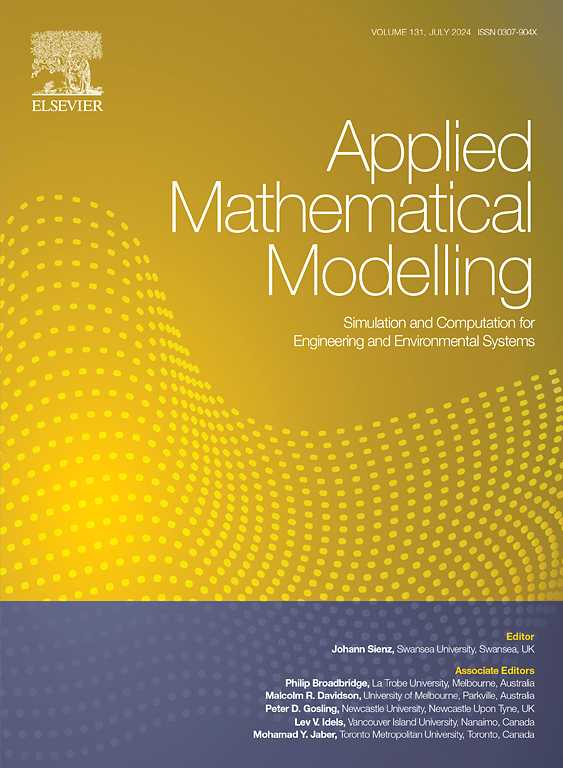不同自由度下输电线路奔驰模型参数辨识研究
IF 4.4
2区 工程技术
Q1 ENGINEERING, MULTIDISCIPLINARY
引用次数: 0
摘要
输电线路的驰变现象一直是人们关注的话题,而建立准确的驰变模型是一项极具挑战性的工作。因此,采用非线性动力学稀疏识别(SINDy)、积分SINDy (ISINDy)和弱SINDy (WSINDy)算法从数据中直接识别飞奔模型。以结冰四束导体的驰动为例,建立了不同自由度下的理论力学模型。利用理论模型得到的仿真数据,利用这三种算法对驰骋模型进行参数辨识。针对1-DOF和2-DOF驰动模型,采用Hodrick-Prescott (hp)滤波方法对数据进行预处理,比较了三种算法在不同噪声水平下的参数识别效果。利用无噪声数据分析了三种算法对三自由度驰骋模型的参数辨识效果,并比较了三种算法在不同数据长度下的鲁棒性。研究结果表明,WSINDy算法在变自由度飞奔模型参数辨识过程中具有较高的精度和鲁棒性,优于SINDy和ISINDy算法。在工程应用中,识别模型对验证防驰设计和制定防驰方案起着至关重要的作用。本文章由计算机程序翻译,如有差异,请以英文原文为准。
Research on parameter identification of transmission line galloping model under different degrees of freedom
The phenomenon of galloping in transmission lines has long been a topic of significant interest, and establishing an accurate galloping model is highly challenging. Consequently, the sparse identification of nonlinear dynamics (SINDy), Integral SINDy (ISINDy), and Weak SINDy (WSINDy) algorithms are employed to directly identify galloping models from data. A theoretical mechanical model is established for different degrees of freedom (DOFs), using the galloping of iced quad bundle conductors as an illustrative example. Simulated data obtained from the theoretical model are utilized to perform parameter identification of the galloping model using the three algorithms. For the 1-DOF and 2-DOF galloping models, the data is preprocessed using the Hodrick-Prescott (H-P) filter method, and then the parameter identification effects of the three algorithms are compared under different noise levels. The parameter identification effects of the three algorithms for the 3-DOF galloping model are analyzed using noise-free data, while also comparing their robustness across different data lengths. The research findings demonstrate that the WSINDy algorithm exhibits high accuracy and robustness in the parameter identification process of galloping models with varying DOF, surpassing the performance of the SINDy and ISINDy algorithms. The identification models play a crucial role in validating anti-galloping designs and formulating anti-galloping plans in engineering applications.
求助全文
通过发布文献求助,成功后即可免费获取论文全文。
去求助
来源期刊

Applied Mathematical Modelling
数学-工程:综合
CiteScore
9.80
自引率
8.00%
发文量
508
审稿时长
43 days
期刊介绍:
Applied Mathematical Modelling focuses on research related to the mathematical modelling of engineering and environmental processes, manufacturing, and industrial systems. A significant emerging area of research activity involves multiphysics processes, and contributions in this area are particularly encouraged.
This influential publication covers a wide spectrum of subjects including heat transfer, fluid mechanics, CFD, and transport phenomena; solid mechanics and mechanics of metals; electromagnets and MHD; reliability modelling and system optimization; finite volume, finite element, and boundary element procedures; modelling of inventory, industrial, manufacturing and logistics systems for viable decision making; civil engineering systems and structures; mineral and energy resources; relevant software engineering issues associated with CAD and CAE; and materials and metallurgical engineering.
Applied Mathematical Modelling is primarily interested in papers developing increased insights into real-world problems through novel mathematical modelling, novel applications or a combination of these. Papers employing existing numerical techniques must demonstrate sufficient novelty in the solution of practical problems. Papers on fuzzy logic in decision-making or purely financial mathematics are normally not considered. Research on fractional differential equations, bifurcation, and numerical methods needs to include practical examples. Population dynamics must solve realistic scenarios. Papers in the area of logistics and business modelling should demonstrate meaningful managerial insight. Submissions with no real-world application will not be considered.
 求助内容:
求助内容: 应助结果提醒方式:
应助结果提醒方式:


